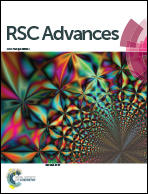Electrochemical immunosensor based on an antibody-hierarchical mesoporous SiO2 for the detection of Staphylococcus aureus
Abstract
The outbreak of food-borne pathogens has become a serious concern; therefore, the detection of pathogenic bacteria in food is required. Untreated, sensitive, and reliable sensors should be developed for the detection of Staphylococcus aureus (S. aureus). In this study, a sensitive antibody-based electrochemical immunosensor was developed using antibody (Ab)-hierarchical mesoporous silica (HMS) bio-conjugates for label-free detection of low concentrations of S. aureus. First, a bio-template method based on butterfly wings was used to prepare the HMS. Then, the carrier material was amino-functionalized to cross-link the antibody with glutaraldehyde. The Ab-HMS bio-conjugates were then immobilized on a glassy carbon electrode (GCE), and the presence of S. aureus was detected by analyzing the changes in the peak currents after the antigen–antibody complex formation. Differential pulse voltammetry (DPV) was performed with bacterial concentrations ranging from 10 to 2 × 103 colony forming units (CFU) mL−1. Selective tests were performed using Escherichia coli (E. coli), Listeria monocytogenes (L. monocytohenes), and Salmonella, and the selective assays showed specific detection of S. aureus using the sensor. In addition, the immunosensor showed a good linear relationship between the peak current increase and logarithmic S. aureus concentration (R2 = 0.9759) with a fast detection time (20 min) and detection limit of 11 CFU mL−1. When the electrochemical impedance spectroscopy (EIS) was performed under the same conditions, the results showed a good linear relationship between the impedance change value and the bacterial concentration (R2 = 0.9720), the limit of detection (LOD) was 12 CFU mL−1. The performance of the sensor was compared with that of the colony counting method in the spiked milk sample test. The results showed no significant difference in the test results. Hence, this electrochemical immunosensor can be used to quickly detect S. aureus in actual food samples with a high sensitivity, specificity and stability.



 Please wait while we load your content...
Please wait while we load your content...